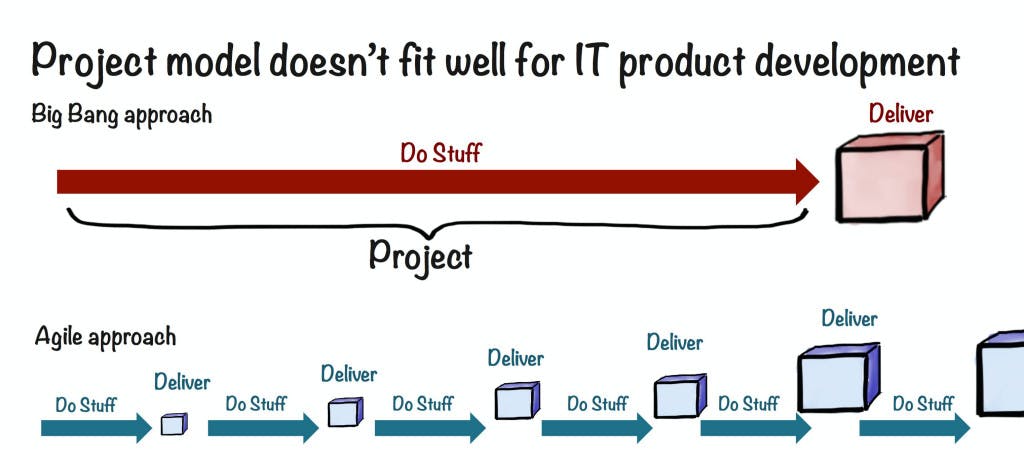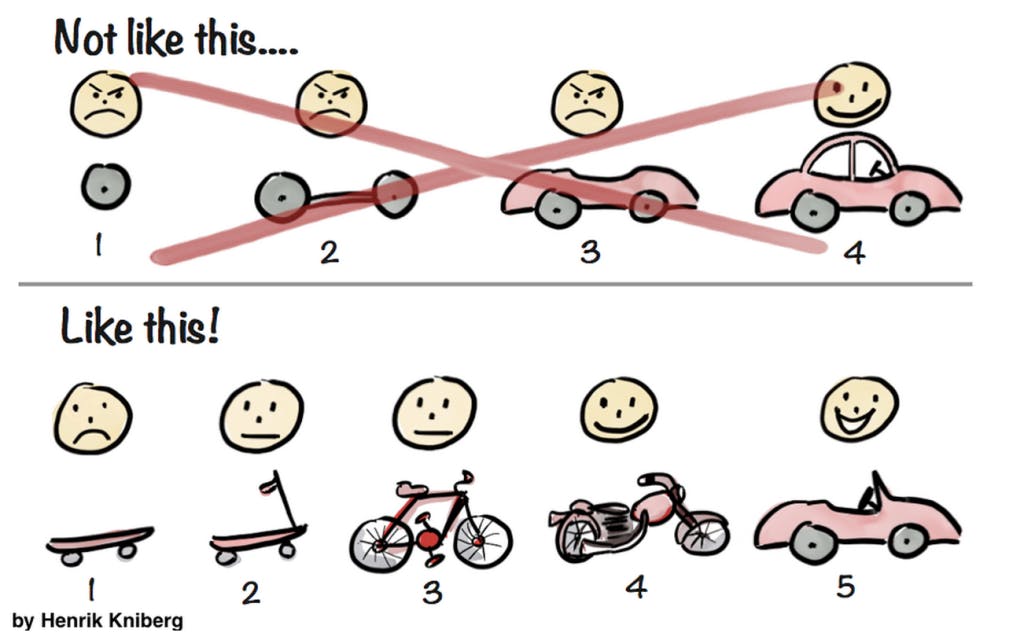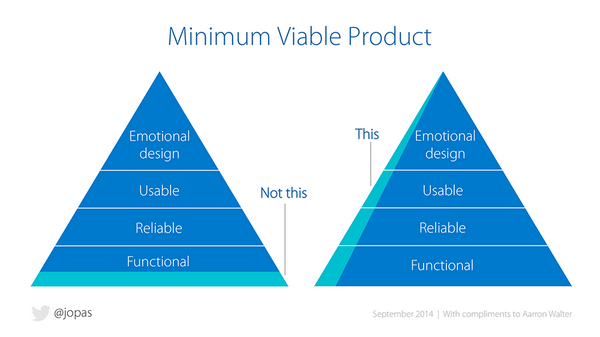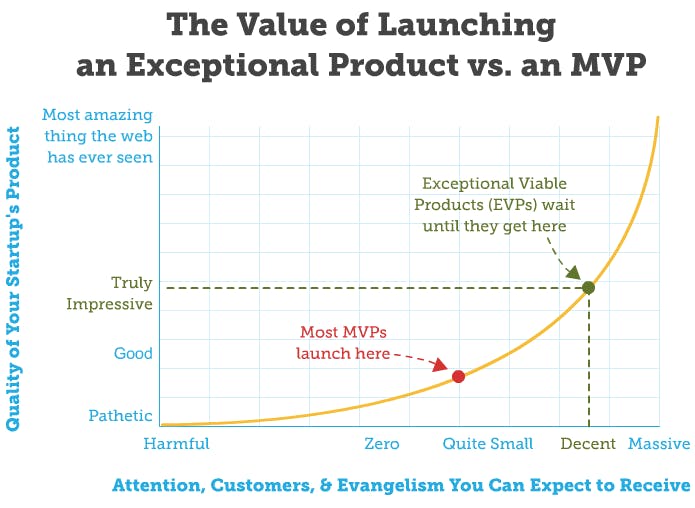Your marketplace MVP – How to build a Minimum Viable Platform
What you should focus on when you’re creating the first version of your marketplace platform.
Published on
Last updated on

This chapter of the practical guide on how to create a marketplace helps you define the requirements for a successful marketplace MVP that users will love from day one. Also available in audio!
Once you have gone through the initial process of customer discovery, you should have a relatively good idea about what your users' real problems are and how to solve them.
In other words, you should be close to problem-solution fit. The next step is achieving product-market fit—finding a big enough market with a product that can satisfy that market.
To find product/market fit, you need to build a minimum viable product (MVP): a minimal solution that solves the core problem of your users better than other existing solutions. The product is then released to your users to kick off the learning process.
In this chapter, we focus on how to build your MVP.
The term Minimum Viable Product was popularised by startup gurus Eric Ries and Steve Blank. Blank refers to the approach of an MVP as "selling the vision and delivering the minimum feature set to visionaries, not everyone."
It is important to define who your early adopters are—the people most eager to try out your solution and give feedback—and then develop the core feature set (and nothing more) that allows you to solve their needs. After they start using your product, these early adopters will provide you with invaluable information about how to improve the product. You should continuously listen to their input, make small improvements based on it, deliver these improvements to them and talk to them again to see if the issues were solved.
The concept of MVP is closely related to the field of Agile software development. The point of agility is to build, deliver and learn quickly. Agile and lean coach Henrik Kniberg describes the benefits of the agile approach versus the traditional waterfall-style product development in his presentation and illustrates them with the following picture:

Even when building an MVP, you need to know what to build. Many startups fail because they start building an MVP without proper pre-validation and end up with products that nobody uses. For true learning to happen, your MVP needs to be good enough to really solve an identified problem. The following picture from Henrik Kniberg illustrates how to approach building an MVP and how not to do it.

In some cases, building a working solution is a complex process that requires lots of work. Typical examples include physical products or more advanced software solutions. In these cases, the MVP can be a non-functional prototype that validates demand before getting the actual product in the hands of customers. For example, you might make a video that explains how the product works and combine it with a call to action to purchase the product or sign up. Pebble (later acquired by Fitbit) did this with their successful smartwatch Kickstarter campaign, and file storage service Dropbox did it with their product video and mailing list.
However, if it is possible to get a working prototype in the hands of customers with relatively little effort, that is definitely the recommended approach. The launch story of Buffer, a social media automation tool, is a great case study on this. They went from idea to paying customers in 7 weeks. Choosing the right marketplace software for your idea can get you launched in a lot less.
A common mistake entrepreneurs make is to assume that the MVP can be really buggy or ugly. This is not the case. While the MVP does not necessarily need to be polished to perfection, it needs to contain a set of required features—ones that work properly and delight the user. If your software is broken or looks unfinished, it will give a very bad first impression and deter users. The following illustration by user experience designer Jussi Pasanen exemplifies how you should approach the MVP.

Alex Iskold, Managing Partner at 2048 Ventures in NYC, notes how the emphasis of startups that are building their MVPs is too often on the word minimum. Founders following the lean startup principles tend to misinterpret the concept of MVP and launch products that are too raw and simple. This results in nobody using them and entrepreneurs concluding that their entire idea is bad when the MVP just was not quite there yet. Do not fall into this trap.
Instead of focusing on just being minimum or viable, I like to encourage budding marketplace entrepreneurs to design MVPs that aim to delight their early adopter users. This approach is called building a Minimum Lovable Product (MLP), a term coined by the great team behind The Happy Startup School. The MLP is “the version of a new product that brings back the maximum amount of love from your early tribe members with the least effort.” I highly recommend checking out their 10 tips to go from viable to lovable.
Marketing expert Rand Fishkin also talks about the same issue. He encourages entrepreneurs to “not deliver mediocrity but put in the time and effort required to be remarkable” and build an exceptional viable product before releasing it. He illustrates this approach with the following diagram.

We have been talking about Minimum Viable Products in general and are now going to focus specifically on marketplaces. In the case of a marketplace business, an MVP means a Minimum Viable Platform. This term was coined by marketplace expert Sangeet Paul Choudary, who discusses how a platform should start by providing a single interaction between its two sides.
There is no going around it: when building a marketplace business, you can only validate product/market fit by launching a platform and getting your users to transact on it. In this particular field, a crowdfunding campaign or a video is not enough—as we've learned, many people will say they love your idea and may even sign up, but the real test is whether they will use your platform to interact with other users. Only then will you know that you are truly providing value.
Let's go back to the example of building a marketplace for personal trainers services that we used in the previous chapter. You have interviewed some potential users and identified the most promising customer segment. The main assumptions from both the customers' and providers' points of view were validated. You now have a clear value proposition for both sides of your marketplace, and based on the interviews, you are quite sure it is a big enough problem to solve. You write down your value propositions as follows:
- Value proposition for customers (wealthy stay-at-home moms between 30 and 50): Easy to use and unified search experience that aggregates many personal trainers into one place, allows comparisons based on offerings and the number of reviews they have received, and makes it easy to book a suitable time slot and pay for it.
- Value proposition for providers (personal trainers): Easy way to set up their own online presence, more leads, handy tools for managing bookings and invoicing.
Now you are ready to build a minimum viable solution that offers this value proposition. The only true validation of your idea is if your earlyvangelists start booking personal training services through your solution. This is your goal for this stage.
This video is part five of our video course on building a successful marketplace.
How can you build the MVP (or, more precisely, the Minimum Lovable Platform) if you are not a programmer? For many, the first idea that comes to mind is outsourcing. However, this might not be the best option and can potentially lead to a lot of wasted time and money. In his excellent post, Buffer's CEO Joel Gascoigne lays out why he believes you should not outsource your startup:
– With startups, we live in a world of 'unknown problem, unknown solution' situations. We don't know whether our new idea will work. It takes a whole different approach, and I think this is almost always misaligned with the way a freelancer will approach things.
Another approach is to find a technical co-founder and have them build the MVP for free. However, this is easier said than done. As Gascoigne notes: "I believe you'll struggle to find a great technical co-founder if all you have is your idea." If you are going to wait until you find a suitable person, you might need to wait for a long time. And as we have discussed, it is vital to launch your idea early.
So, what to do? Gascoigne answers:
– I honestly believe that building your product yourself is the most optimal and, in fact, the fastest path to creating a successful startup.
The challenge: programming even a simple marketplace platform for scratch is difficult, even for experienced developers. There are many complicated things to consider when building a multi-sided platform with monetary transactions. Teaching yourself to code and building everything from scratch might thus not be a viable option and would likely take too much time.
Today's aspiring entrepreneurs are, however, in luck. As Gascoigne notes: "It's my belief that, especially today, you can create a fully working (albeit potentially somewhat manual) version of your startup without coding at all." This approach is sometimes called manual-first startup or concierge MVP.
Back to our example of a personal trainer marketplace. You could start by convincing ten personal trainers to offer their services through your platform. The next step is to create a simple landing page—using a tool like Unbounce, Instapage, or Strikingly which require no coding—with a list of the personal trainers, descriptions of their services, and prices. You would also create a simple booking form (with a free tool like Typeform or Google Forms) that would simply ask for the customer's email address, the trainer they want to book from, and the desired time.
Each booking email would land in your inbox. You would then communicate with the trainer and the customer to arrange a suitable date and would ask the customer to confirm the booking by paying. You could use a solution like PayPal Checkout to accept incoming payments, after which you can transfer the payment (minus your commission fee) to the trainer.
After each successful booking, you would email the customer and ask them to rate the provider. You would then manually add the review to your landing page.
Whenever someone makes a booking request, you can add their email address to a mailing list tool like MailChimp. Whenever you add new personal trainers to the system or have special offers from existing providers, you can email all the people on your list.
The solution described above offers your basic value proposition to both sides of your marketplace. This approach is exactly what Airbnb initially started with, and it worked well for them. As Jared Friedman (partner at Y Combinator) explained at the RiseUp Summit 2015:
– The first version of Airbnb was a WordPress blog where they just put down a list of apartments you can rent. They didn't even write any code. In order to rent, you would just leave a comment on the blog saying you want to stay there. It was super ghetto! But in launching that, they were able to see what people want.
Today, Airbnb has amazing design and loads of features, but most of that was built only after the basic concept was thoroughly validated.
You can go even simpler than a landing page. Ryan Hoover talks about email-first startups, which don't necessarily even have a landing page but instead just an email address where the users can post their needs.
The manual approach described above might be enough to get the first few bookings. However, it is possible that it would not be a good enough Minimum Lovable Platform for your users:
- When there are lots of providers, the landing page does not scale: filtering and searching for providers becomes difficult.
- Since you handle the communication for bookings manually, the process would not be instantaneous.
- Communicating with you to handle scheduling might be too big a hassle for the providers.
It is good to keep in mind that the web has evolved a lot since the days Airbnb got started. People are now more used to searching, making bookings, and paying online and are used to stellar user experiences. In other words, the bar is a lot higher. As Rand Fishkin says, it is not enough to deliver something that works - you need to deliver something exceptional from the beginning.
Content Management Systems (CMS) like WordPress have also evolved. Today, it is possible to build a fully-fledged marketplace with WordPress by purchasing the right themes and plugins. Drupal, a platform I am familiar with, also offers similar options. With these themes and plugins, you can automate more and more steps and improve the user experience.
However, the more complicated the solution you are trying to build with these tools, the more difficult it tends to get. I have lots of experience with both Drupal and WordPress and have noticed first-hand that you can easily spend hundreds of hours learning how to do something. It is quite likely that you need to teach yourself at least a bit of coding to be able to customize your platform enough. You also need to handle things like setting up your own server and installing the CMS on it with all the desired themes and plugins. If you do not have programming skills, this approach can be surprisingly daunting. It can easily defeat the purpose of launching and iterating quickly.
So, what to do?
The Marketplace Academy is a website built and maintained by Sharetribe. I have been working closely with their core team to write this guide, so this part of the article is definitely biased. However, including it is important since Sharetribe was created to solve this very problem: to help aspiring marketplace entrepreneurs without technical skills launch Minimum Lovable Platforms as quickly and easily as possible.
With Sharetribe, you can create a fully functional marketplace in one day and launch it to your users right away. Your users (both providers and customers) can sign up, create their online profile, add their services, search for services they need, filter based on the criteria they choose, make bookings, pay, and review each other through the site. They can do all of this themselves—there's no need for you to do any of it for them.
Compared to the approaches discussed above, there are many benefits to using Sharetribe:
- The user experience is professional. Sharetribe's software has been built and honed over several years.
- It is easier to set up than the landing page and email-based approach: there is only one tool to configure, and there is a lot less manual in running the platform.
- While Sharetribe is a CMS like WordPress, it is easier to learn and set up since it has been built specifically for creating marketplaces. WordPress—which can be used to create nearly any type of website—is more flexible but is also a lot more complicated to set up as a marketplace.
- Using WordPress or Drupal usually requires you to set up and manage your own server. Sharetribe does all that for you, taking care of all the administrative work. You do not need to write a single line of code or understand anything about servers to use Sharetribe.
- Offer smooth marketplace payments from day one. You do not need to hold money on behalf of your providers and manually transfer funds to them. Sharetribe's payment system has been built in a way that the money from transactions never touches your account while still giving you your commission. You avoid all sorts of legal problems related to holding money on behalf of your providers.
- Sharetribe is infinitely extensible. If, at some point, you want to hire a development team to build a more customized solution, you can do that on top of Sharetribe's headless codebase.
- Using Sharetribe will not break your budget. You get a free 14-day trial, after which the Build plan is only $39/month. When you're ready to invite in actual users, live plan fees start at only $99 per month.
A great example of using Sharetribe to create an MVP is the story of Studiotime, an "Airbnb for record studios". Founder Mike Williams essentially decided to skip dinner and build an MVP for his idea in one evening. Thanks to Sharetribe Go, Sharetribe's earlier no-code software, he was able to do just that and start the validation process right away. He launched the site to huge acclaim at Product Hunt, and suddenly hundreds of studios signed up. Later, Mike invested in doing custom development work on top of the headless marketplace software, Sharetribe Flex—but only after he got initial validation for product/market fit. Less than a year later, Studiotime was already a profitable and sustainable business for Mike. (Sharetribe Flex has since grown into Sharetribe's reimagined marketplace builder that combines a powerful no-code builder with infinite extensibility.)
There are also other alternatives to Sharetribe for building marketplaces. This Quora thread provides a good list of options. Different solutions suit different types of platforms. For instance, if you are planning to build a marketplace like Amazon—where multiple big retailers sell their products to consumers from large inventories—Sharetribe might not be the right fit for you, and you could try Mirakl or IZBERG Marketplace instead.
Once your MVP is ready, you can launch it to your users. However, before launching, it is important to define what you want to learn from the launch. Remember that the launch of the MVP is just an experiment, the purpose of which is to provide you with information about whether your assumptions were correct. As Eric Ries notes, if your goal is to simply launch something and see what happens, you'll always succeed in that, but it doesn't necessarily help you validate your assumptions.
The key questions you should answer before launching the MVP are the following:
- What assumptions are you trying to validate in this experiment?
- What data are you collecting through this experiment?
- What determines the success or failure of this experiment?
To answer these questions, you need to define the most important marketplace metrics or Key Performance Indicators (KPIs) of your marketplace business. These indicators need to be actionable: if the figures are not what you expected, you need to act on them and change something. We will go deeper into this topic in an upcoming chapter of this guide.
A Minimum Viable Product (MVP)—or, in the case of marketplaces, Minimum Viable Platform—can be defined as the minimal solution that solves your users' core problem better than alternative solutions. In the case of marketplaces, your MVP needs to provide a solution to both sides of the marketplace. However, it is good not to focus too much on the word minimum since the solution also needs to delight your users. A better way might be to talk about a Minimum Lovable Platform instead.
The best approach to building an MVP is to do it yourself instead of relying on a technical co-founder or outsourcing it. If you are not technical, you can either build an MVP using a manual-based approach with landing pages and email lists or use a ready-made tool like Sharetribe to create a fully functional platform. After you have an MVP, you should define your Key Performance Indicators (KPIs) that help you validate your assumptions and then launch your MVP to your users to see if the assumptions really hold true.
You might also like...

How to communicate your marketplace value proposition
Making sure every visitor knows how your marketplace can help them.

Marketplace software: How to compare and choose the best solution
There are dozens of online marketplace software alternatives to choose from. Learn how to make the right choice for your marketplace idea.

How much does it cost to build a marketplace business?
Example of a first year’s marketplace startup budget, and how to spend it wisely.

Marketplace funding: The complete guide
Struggling with funding your marketplace? This guide helps you decide how much marketplace funding you need – and when and where to source it.
Start your 14-day free trial
Create a marketplace today!
- Launch quickly, without coding
- Extend infinitely
- Scale to any size
No credit card required
